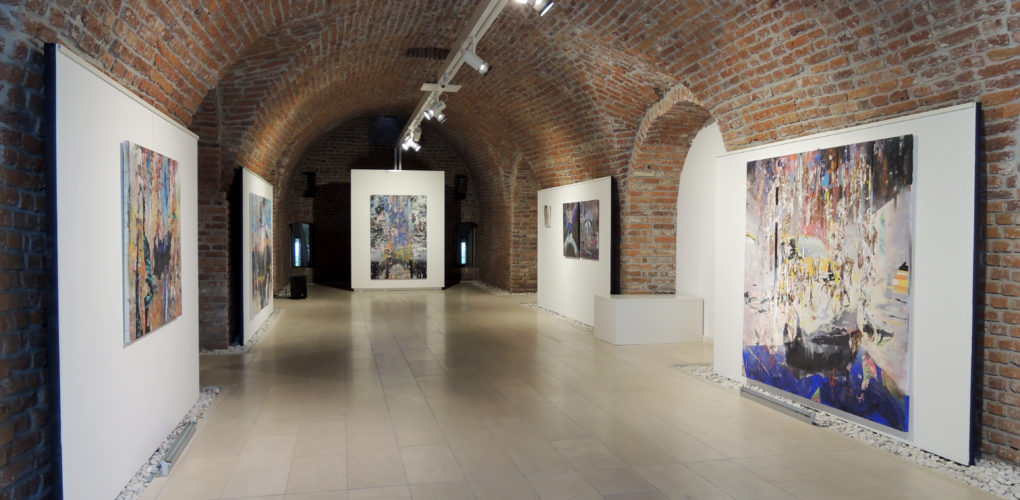One to Watch
 Edith Torony: Exploring the Periphery of Consumer Culture
Edith Torony: Exploring the Periphery of Consumer Culture
Edith Torony draws upon the visual culture of urban life and the internet to explore the impact of waste and consumerism on the environment. Between the breakneck speed of online information sharing and the disposable nature of consumer products, modern life leaves a hoard of daily waste in its wake. Much like the way dreams indiscriminately recycle bits of memory and information from our day, Edith recomposes the detritus of our digital and consumer culture into whimsical landscapes. Painted with solidity and urgency, Edith’s colorful discards and junk reign supreme over their environments, taking on new meanings and narratives—and perhaps even sending us a warning.
Edith has exhibited her work throughout Europe, including at the 2017 Positions Art Fair in Berlin, UnaGaleria in Bucharest, and Five Plus Art Gallery in Vienna. She holds an M.A. from West University of Timisoara, Faculty of Arts and Design, and her work is now held in collections across North America and Europe.
1. Tell us about who you are and what you do. What’s your background?
My name is Edith Torony. I’m a visual artist from Timisoara, Romania. I currently live and work in Ghiroda, a small locality nearby Timisoara.
2. What does your work aim to say? What are the major themes you pursue in your work?
Throughout the years I experimented a lot and kept changing my my style. At the crossroads between abstract and figurative, my works are influenced by changes in my life and [my] surroundings. Starting with the series Junkyard Symphony, my paintings have gradually become more of a surrealist journey into the universe of the urban periphery. My paintings capture the devastating effects of junk invasion and consumerism on our environment. Allegorically recomposed, all these reminiscences of our daily waste are caught dancing, floating in their singularity. In more recent series like Personal Mythologies, Hybrid Playground or Synthetic Future, they even start to create their own story. With an increasing appearance of figurative elements and even insertions of pop art, works like “Synthetic Future” criticize capitalism, consumerism, waste and pollution, sending a warning sign about the future.
3. Can you walk us through your process for creating a work from beginning to end?
First I take a lot of photos, as I can find something interesting anywhere that can be used in my works. I search the internet for different shapes, objects or spaces that can be manipulated and integrated in my compositions. Sometimes I use these pictures years later. When I start working on the background I like to be very spontaneous and gestural, working with big brush strokes and spray paint. I’m always looking to preserve the freshness of my paintings, even when I integrate detailed objects or shapes. Most of the time the background leads me to see something fitting, a shape or an object I could put there. I don’t like controlling the work too much in the beginning. After considering the background finished, I come up with a composition of shapes and objects, depending on what inspires me in that moment, from my personal life or from the outside.
4. What series or artistic project are you working on next?
I developed a new series named Synthetic Future last year in late summer. I already exhibited the first works in 2019 in Wien, Austria, but that was just the beginning. Since then I have worked to expand the series, to evolve and give a different feel in my latest works. I like my works to be a fusion of gestural, abstract painting with surreal or mysterious scenes and moods where the eye can also find some peaceful areas to rest on. But in Synthetic Future I want elements to be more and more concretely shaped and intense in color, similar to what we see in the aesthetic of advertisements, supermarkets or products’ packing design. This aesthetic is an invasion of information and products, so I want my works to look like that—more powerful and disturbing.
5. Why art?
I spent a lot of time in my father’s studio as a child. He is also a painter, so I was always surrounded by art. However, it was after I decided to study art in high school and then in university that I finally discovered more of myself, or, in other words, that I started to create myself as a visual seeker/explorer. In this situation, I always wondered if I would have pursued art alone, without such direct influence [from my father]. But, knowing myself, my curiosity for a lot of things and meanings, for creativity, I came to realize I would always choose it, for sure. Art for me is the ultimate state of freedom that humanity can have. To express not only the beauty but also the ugliness—our desires, social, [and] political problems. Art should always be there as a bridge between different people or cultures, challenging us to be better.
Love reading about all things art? You can have articles from Canvas, curated collections, and stories about emerging artists delivered straight to your inbox. Sign up for the Saatchi Art Newsletter.

















